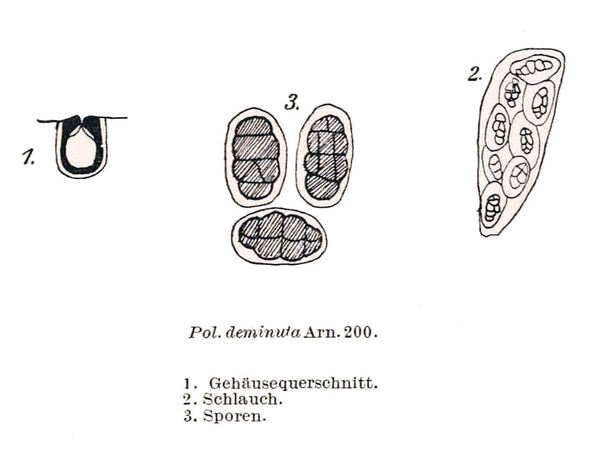Halospora deminuta (Arnold) Tomas. & Cif.
Arch. Bot. Ital., 28: 11, 1952. Basionym: Polyblastia deminuta Arnold - Flora, 44: 264, 1861.
Synonyms: Amphoroblastia deminuta (Arnold) Servít; Merismatium deminutum (Arnold) Cl. Roux & Nav.-Ros.; Verrucaria deminuta (Arnold) Leight.
Distribution: N - TAA (Roux & al. 2002, Hafellner 2011, Brackel 2016), Lomb (Brackel 2016).
Description: Thallus not visible, not lichenized, growing on endolithic lichens and suppressing the formation of their ascomata. Perithecia (pseudothecia) black, 0.2-0.3 mm across, mostly developing in pits left by fallen ascomata of the host lichen, not fitting in size with the holes, being much smaller. Involucrellum absent; exciple brown to dark brown throughout, K+ darker brown, faintly violet around the ostiole; hyphae surrounding exciple colourless to brownish; hamathecium of short pseudoparaphyses and periphyses forming a crown above the asci and lining the ostiolar canal; hymenial gel I+ red, K/I+ blue. Asci 8-spored, subcylindrical to narrowly clavate, thick-walled when young, without ocular chamber, K/I-. Ascospores muriform, with 3-4(-5) transverse septa and (1-)3-4(-6) longitudinal septa, brown, ellipsoid, (19.5-)20-28(-29.5) x (10-)11-15(-17) µm, 1.5-2(-2.3) times as long as wide, surrounded by a distinct, 1.5-3 µm thick halo. Photobiont absent. Spot tests: K-, C-, KC-, P-, UV-. Chemistry: without lichen substances. Note: on steeply inclined surfaces of calcareous rocks in upland areas, often in association with Hymenelia coerulea, on Thelidium, Polyblastia and other endolithic lichens. The formation of the ascomata of the host is often suppressed, and the lichenicolous behaviour is indicated by the ascomata of the species, mostly developing in the pits left by fallen ascomata of the host lichen, not fitting in size with the holes, being much smaller (Hafellner 2011). Records from Venezia Giulia reported by Nimis (1993: 555), being dubious, are not accepted here.
Growth form: Lichenicolous fungus
Substrata: rocks
Reproductive strategy: mainly sexual
paras endolithic lichens
Commonnes-rarity: (info)
Alpine belt: absent
Subalpine belt: extremely rare
Oromediterranean belt: absent
Montane belt: very rare
Submediterranean belt: absent
Padanian area: absent
Humid submediterranean belt: absent
Humid mediterranean belt: absent
Dry mediterranean belt: absent

Predictive model
Growth form: Lichenicolous fungus
Substrata: rocks
Reproductive strategy: mainly sexual
paras endolithic lichens
Commonnes-rarity: (info)
Alpine belt: absent
Subalpine belt: extremely rare
Oromediterranean belt: absent
Montane belt: very rare
Submediterranean belt: absent
Padanian area: absent
Humid submediterranean belt: absent
Humid mediterranean belt: absent
Dry mediterranean belt: absent

Predictive model
 INDEX FUNGORUM
INDEX FUNGORUM
 GBIF
GBIF
 DOLICHENS
DOLICHENS



